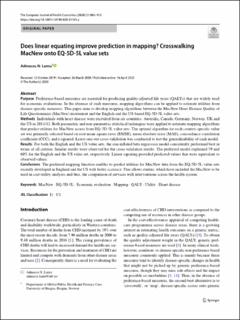| dc.contributor.author | Lamu, Admassu Nadew | |
| dc.date.accessioned | 2021-07-15T09:21:09Z | |
| dc.date.available | 2021-07-15T09:21:09Z | |
| dc.date.created | 2020-04-18T10:39:59Z | |
| dc.date.issued | 2020 | |
| dc.identifier.issn | 1618-7598 | |
| dc.identifier.uri | https://hdl.handle.net/11250/2764481 | |
| dc.description.abstract | Purpose: Preference-based measures are essential for producing quality-adjusted life years (QALYs) that are widely used for economic evaluations. In the absence of such measures, mapping algorithms can be applied to estimate utilities from disease-specific measures. This paper aims to develop mapping algorithms between the MacNew Heart Disease Quality of Life Questionnaire (MacNew) instrument and the English and the US-based EQ-5D-5L value sets.
Methods: Individuals with heart disease were recruited from six countries: Australia, Canada, Germany, Norway, UK and the US in 2011/12. Both parametric and non-parametric statistical techniques were applied to estimate mapping algorithms that predict utilities for MacNew scores from EQ-5D-5L value sets. The optimal algorithm for each country-specific value set was primarily selected based on root mean square error (RMSE), mean absolute error (MAE), concordance correlation coefficient (CCC), and r-squared. Leave-one-out cross-validation was conducted to test the generalizability of each model.
Results: For both the English and the US value sets, the one-inflated beta regression model consistently performed best in terms of all criteria. Similar results were observed for the cross-validation results. The preferred model explained 59 and 60% for the English and the US value set, respectively. Linear equating provided predicted values that were equivalent to observed values.
Conclusions: The preferred mapping function enables to predict utilities for MacNew data from the EQ-5D-5L value sets recently developed in England and the US with better accuracy. This allows studies, which have included the MacNew to be used in cost-utility analyses and thus, the comparison of services with interventions across the health system. | en_US |
| dc.language.iso | eng | en_US |
| dc.publisher | Springer | en_US |
| dc.rights | Navngivelse 4.0 Internasjonal | * |
| dc.rights.uri | http://creativecommons.org/licenses/by/4.0/deed.no | * |
| dc.title | Does linear equating improve prediction in mapping? Crosswalking MacNew onto EQ‑5D‑5L value sets | en_US |
| dc.type | Journal article | en_US |
| dc.type | Peer reviewed | en_US |
| dc.description.version | publishedVersion | en_US |
| dc.rights.holder | Copyright the author 2020 | en_US |
| cristin.ispublished | true | |
| cristin.fulltext | original | |
| cristin.qualitycode | 1 | |
| dc.identifier.doi | https://doi.org/10.1007/s10198-020-01183-y | |
| dc.identifier.cristin | 1806895 | |
| dc.source.journal | European Journal of Health Economics | en_US |
| dc.source.pagenumber | 903-915 | en_US |
| dc.identifier.citation | European Journal of Health Economics. 2020, 21, 903-915. | en_US |
| dc.source.volume | 21 | en_US |

